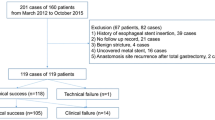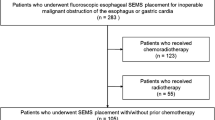Abstract
Purpose
To evaluate the efficacy and safety of a novel technique for removal of migrated esophageal stent (MES) under fluoroscopy.
Methods
From January 2009 to April 2023, 793 patients with a dysphagia score of 3–4 underwent esophageal stenting at our center, and 25 patients (mean age: 70.06 years old; male/female: 15/10) underwent stent removal using “loop method” under fluoroscopy. The primary outcomes were technical success and complications. The secondary outcomes were procedure time, radiation exposure, biochemical indicators [white blood cell (WBC), hemoglobin (Hb), platelet (PLT), albumin (ALB), alanine transaminase (ALT), total bilirubin (TB), urea nitrogen (UN) and C-reactive protein] of pre- and post-treatment at 2 weeks.
Results
Technical success was 100% without major complications. The mean procedure time was (39.44 ± 9.28) minutes, which showed no statistical significance between benign (n = 5) and malignant (n = 20) group [(42.40 ± 8.85) vs (38.71 ± 9.46) mins, p > 0.05]. The mean radiation exposure was (332.88 ± 261.47) mGy, which showed no statistical significance between benign and malignant group [(360.74 ± 231.43) vs (325.92 ± 273.54) mGy, p > 0.05]. Pre- and post-procedure Hb [(114.46 ± 11.96) vs. (117.57 ± 13.12) g/L] and ALB [(42.26 ± 3.39) vs. (44.12 ± 3.77) g/L] showed significant difference (p < 0.05), while WBC, PLT, CRP, and ALT showed no significance (p > 0.05).
Conclusion
Fluoroscopy-guided “Loop method” for MES removal is an effective and safe alternative technique.



Similar content being viewed by others
Data availability
In addition to the raw data in the manuscript, the datasets used are available from the corresponding author on availability of data and materials.
References
Liu C, Ma Y, Qin Q, Wang P, Luo Y, Xu P, Cui Y (2022) Epidemiology of esophageal cancer in 2020 and projections to 2030 and 2040. Thoracic Cancer 14:3–11. https://doi.org/10.1111/1759-7714.14745
Ross AS, Kozarek RA (2012) Esophageal stents: indications and placement techniques. Self-expandable stents in the gastrointestinal tract 129–140. https://doi.org/10.1007/978-1-4614-3746-8_9
Vermeulen BD, Siersema PD (2018) Esophageal Stenting in Clinical Practice: an Overview. Curr Treat Options Gastro 16:260–273. https://doi.org/10.1007/s11938-018-0181-3
Bakken JC, Wong Kee Song LM, de Groen PC, Baron TH (2010) Use of a fully covered self-expandable metal stent for the treatment of benign esophageal diseases. Gastrointestinal Endoscopy 72:712–720. https://doi.org/10.1016/j.gie.2010.06.028
Adler D (2013) Esophageal Stents: Placement, Complications, Tips, and Tricks. Video Journal and Encyclopedia of GI Endoscopy 1:66–68. https://doi.org/10.1016/S2212-0971(13)70030-X
Tasleem SH, Inayat F, Ali NS, Sattar SBA, Munir A, Zafar F (2018) Small Bowel Perforation Secondary to Esophageal Stent Migration: A Comparative Review of Six Cases. Cureus. https://doi.org/10.7759/cureus.3455
Adam YA, Lim S-TJM, Redmond F, Ryan EJ, Johnston S (2022) Small Bowel Obstruction Secondary to Migration of a Fractured Esophageal Stent. Cureus. https://doi.org/10.7759/cureus.30802
Sacks D, McClenny TE, Cardella JF, Lewis CA (2003) Society of Interventional Radiology Clinical Practice Guidelines. Journal of Vascular and Interventional Radiology 14:S199–S202. https://doi.org/10.1097/01.rvi.0000094584.83406.3e
Delpisheh, A., Veisani, Y., Sayehmiri, K., & Rahimi, E. (2014). Esophageal carcinoma: long-term survival in consecutive series of patients through a retrospective cohort study. Gastroenterology and hepatology 7:101–107.
Nagaraja V, Cox MR, Eslick GD (2014) Safety and efficacy of esophageal stents preceding or during neoadjuvant chemotherapy for esophageal cancer: a systematic review and meta-analysis. Gastrointestinal oncology 5:119–26. https://doi.org/10.3978/j.issn.2078-6891.2014.007
Kaltsidis H, Mansoor W, Park J-H, Song H-Y, Edwards DW, Laasch H-U (2018) Oesophageal stenting: Status quo and future challenges. BJR 91:20170935. https://doi.org/10.1259/bjr.20170935
Eroğlu A (2016) Treatment of complications caused by metallic stent placement in esophageal cancer. Turk Gogus Kalp Dama 24:703–710. https://doi.org/10.5606/tgkdc.dergisi.2016.4456
De Palma GD, Iovino P, Catanzano C (2001) Distally migrated esophageal self-expanding metal stents: Wait and see or remove? Gastrointestinal Endoscopy 53:96–98. https://doi.org/10.1067/mge.2001.110731
Kavurmacı AY, Sekuri A, Öven BB, Ergün M, Pata C (2022) Intestinal obstruction due to a migrated esophageal stent and endoscopic removal. Diagn Interv Endosc 3:78-81. https://doi.org/10.5152/DiagnIntervEndosc.2022.223751
Martins BdaC (2014) Endoscopic management and prevention of migrated esophageal stents. WJGE 6:49 https://doi.org/10.4253/wjge.v6.i2.49
Farkas PS, Farkas JD, Koenigs KP (1999) An easier method to remove migrated esophageal Z-stents. Gastrointestinal Endoscopy 50:277–279. https://doi.org/10.1016/s0016-5107(99)70241-5
Martins B, Sorbello M, Retes F, Kawaguti F, Lima M, Hondo F, Stelko G, Ribeiro U Junior, Maluf-Filho F (2012) Endoscopic removal of migrated esophageal stent - the “grasper and pusher” method. Endoscopy 44:E10–E10. https://doi.org/10.1055/s-0031-1291496
Chandnani M, Cohen J, Berzin TM (2018) Combined Approach of Cryoablation and Stent-In-Stent Technique for Removal of an Embedded Esophageal Stent. Case Reports in Gastrointestinal Medicine 2018:1–4. https://doi.org/10.1155/2018/8619252
Amann ST, Somogyi L (2000) A wire-loop technique for removal of migrated and embedded biliary stents. Gastrointestinal Endoscopy 51:485–486. https://doi.org/10.1016/s0016-5107(00)70453-6
Wang Q, Zhou C, Liu J, Xiong B, Zheng C, Feng G. In situ formation of the loop snare technique for retrieval of foreign bodies from vessels. J Interv Med.1(4):247-251. https://doi.org/10.19779/j.cnki.2096-3602.2018.04.09.
Ou Y, Chen L, Li J, Ye Y, Chen Z, Cai L, Liao J (2022) Endoscopic removal of a migrated esophageal covered self-expandable metal stent: the nylon loop pusher-assisted method.Endoscopy. 2022 54(12):E744-E745. https://doi.org/10.1055/a-1738-9465.
Toya Y, Yamada S, Yanai S, Miyajima S, Matsumoto T (2021) Gastrointestinal: Endoscopic removal of a migrating esophageal metallic stent. J Gastroenterol Hepatol.36(5):1151. https://doi.org/10.1111/jgh.15334.
Funding
This work was funded by Major Science and Technology Innovation of Henan Province (221100310100) and Henan Province Science and Technology Research Projects of 2023 (232102311132).
Author information
Authors and Affiliations
Contributions
All authors contributed to the study conception and design. Material preparation, data collection and analysis were performed by Milan Sigdel and Dechao Jiao. The first draft of the manuscript was written by Milan Sigdel, and all authors commented on previous versions of the manuscript. All authors read and approved the final manuscript. All authors acknowledge the preprint publication.
Corresponding author
Ethics declarations
Competing interests
The authors have no competing interests to declare that are relevant to the content of this article.
Ethics approval and Consent
All procedures performed in studies involving human participants were in accordance with the ethical standards of the institutional and/or national research committee and with the 1964 Helsinki Declaration and its later amendments or comparable ethical standards. The study was approved by the Ethics Committees of the First Affiliated Hospital of Zhengzhou University. The requirement for informed consent was waived by the Ethics Committee of The First Affiliated Hospital of Zhengzhou University because of the retrospective nature of the study.
Additional information
Publisher's Note
Springer Nature remains neutral with regard to jurisdictional claims in published maps and institutional affiliations.
Supplementary Information
Below is the link to the electronic supplementary material.
Supplementary file1 (MP4 3010 kb)
Rights and permissions
Springer Nature or its licensor (e.g. a society or other partner) holds exclusive rights to this article under a publishing agreement with the author(s) or other rightsholder(s); author self-archiving of the accepted manuscript version of this article is solely governed by the terms of such publishing agreement and applicable law.
About this article
Cite this article
Sigdel, M., Zhou, X., Song, M. et al. A novel technique to remove migrated esophageal stent under fluoroscopy. Abdom Radiol (2024). https://doi.org/10.1007/s00261-024-04281-0
Received:
Revised:
Accepted:
Published:
DOI: https://doi.org/10.1007/s00261-024-04281-0




